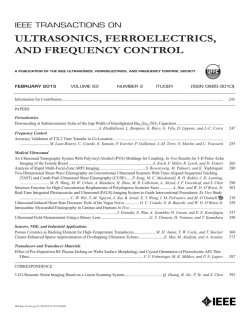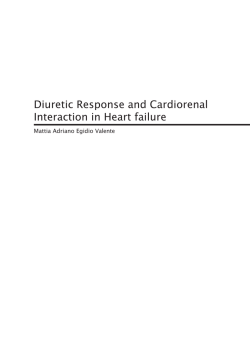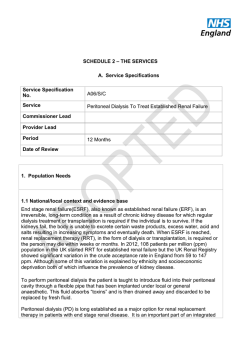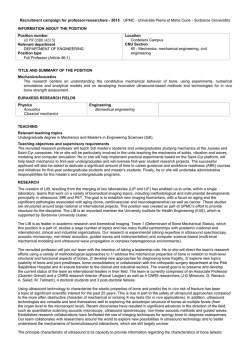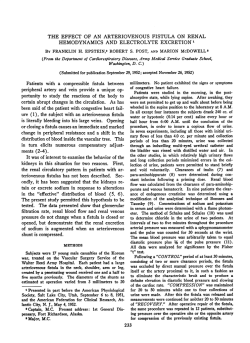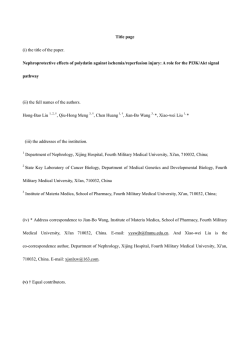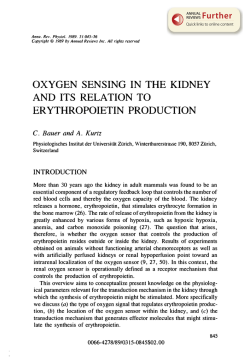
Sonographic evaluation of hydronephrosis and determination of the
International Journal of Medical Imaging 2015; 3(1): 1-5 Published online January 30, 2015 (http://www.sciencepublishinggroup.com/j/ijmi) doi: 10.11648/j.ijmi.20150301.11 ISSN: 2330-8303 (Print); ISSN: 2330-832X (Online) Sonographic evaluation of hydronephrosis and determination of the main causes among adults Suzan Omer Abdelmaboud1, Moawia Bushra Gameraddin1, 2, *, Tarig Ibrahim1, Abdalrahim Alsayed1, 2 1 2 Faculty of Radiological Sciences and Medical Imaging, Alzaiem Alazhari University, Khartoum Bahri, Sudan Department of Diagnostic Radiologic Technology, College of Medical Applied Sciences, Taibah University, Almadinah Almunawwarah, Saudi Arabian Email address: [email protected] (M. B. Gameraddin), [email protected] (S. O. Abdelmaboud), [email protected] (A. Alsayed) To cite this article: Suzan Omer Abdelmaboud, Moawia Bushra Gameraddin, Tarig Ibrahim, Abdalrahim Alsayed. Sonographic Evaluation of Hydronephrosis and Determination of the Main Causes among Adults. International Journal of Medical Imaging. Vol. 3, No. 1, 2015, pp. 1-5. doi: 10.11648/j.ijmi.20150301.11 Abstract: Background: hydronephrosis is one of the most common complication of renal obstructive diseases, if left untreated, it may cause severe complications which may lead to acute and chronic renal failure. Objectives: to assess and classify hydronephrosis and determine the causes using ultrasound. Materials and methods: It is a prospective study, the study population composed of 53 female and 47 male who were suspected with renal diseases and referred to the ultrasound department for investigation. Data collection sheet was designed to include the demographic data such as age, gender, and clinical history. All the patients had been examined with ultrasound using the abdomen and renal ultrasound imaging protocol with 3.5 MHz probe. The renal system (kidneys, urinary bladder and prostate) had been scanned, longitudinal and transverse sections were performed through the kidneys and prostate. Hydronephrosis and the underline causes were measured and reported. Statistical analysis was performed using the standard Statistical Package for the Social Sciences (SPSS Inc., Chicago, IL, USA) version 16 for windows. Descriptive statistics was used to analyze the data. Results: According to sonographic appearance, hydronephrosis had been classified into mild, moderate and severe hydronephrosis. Mild hydronephrosis is most common (53%), moderate (30%), severe hydronephrosis (13%) and extreme hydronephrosis was 4%. There were various causes of hydronephrosis, ureteric stone 31%, kidney stone 23%, pregnancy 12% and benign prostatic hypertrophy 11%. Most of the study population had history of renal stones (63%) Conclusion: Ultrasound is the first line of investigation of the renal system. It is sensitive and accurate to assess and classify the hydronephrosis and determine the main causes. Metabolic disorders (gout and diabetes) were the most risk factors of renal obstructive diseases. Keywords: Sonographic, Evaluation, Hydronephrosis, Determination, Causes 1. Introduction Hydronephrosis refers to dilatation of the renal collecting system most frequently caused by incomplete or complete obstruction. There are many causes of hydronephrosis include congenital blockage(present at birth, scarring of tissue(from injuries or previous surgery), tumors or cancer, vesical mass, urinary tract infection(UTI) and benign prostatic hypertension(BPH) and pregnancy[1,2]. Calculi are the most common cause in adults followed by tumors of the kidney, ureter and bladder. Less common causes are inflammatory ureteral strictures, neurogenic bladder and bladder outlet obstruction [1]. The causes of hydronephrosis are categorized based upon the location of the hydronephrosis and whether the cause is intrinsic (located within the urinary collecting system), extrinsic (outside of the collecting system) or if it is due to an alteration in function [3]. Causes of the hydronephrosis may be detected, such as bladder or ureteral calculi, benign prostatic hypertrophy, pelvic abscesses or tumors. Post-voiding examination may demonstrate disappearance of urinary tract dilatation or massive urine retention if the cause of hydronephrosis is at the bladder outlet [1]. Depending on the level of the cause, hydronephrosis may be unilateral involving one kidney or 2 Suzan Omer Abdelmaboud et al.: Sonographic Evaluation of Hydronephrosis and Determination of the Main Causes among Adults bilateral involving both. The increased pressure caused by hydronephrosis potentially can compromise kidney function if it is not relieved in a reasonable period of time. Patients with hydronephrosis always complain from pain, gross or microscopic hematuria, UTI , acute and chronic renal failure [2,4]. The etiology and presentation of hydronephrosis and/or hydroureter in adults differ from that in neonates and children. Anatomic abnormalities (including urethral valves or stricture, and stenosis at the ureterovesical or ureteropelvic junction) account for the majority of cases in children. In comparison, calculi are most common in young adults, while prostatic hypertrophy or carcinoma, retroperitoneal or pelvic neoplasms, and calculi are the primary causes in older patients [5, 6]. Hydronephrosis or hydroureter is a normal finding in pregnant women. The renal pelvises and caliceal systems may be dilated as a result of progesterone effects and mechanical compression of the ureters at the pelvic brim. Dilatation of the ureters and renal pelvis is more prominent on the right side than the left side and is seen in up to 80% of pregnant women [7].These changes are visible on ultrasound examination by the second trimester, and they may not resolve until 6-12 weeks post-partum. Renal ultrasonography has become the standard imaging modality in the investigation of kidneys because it offers excellent anatomic details, requires no special preparation of patients is readily available and does not expose the patient to radiation or contrast agents. Conventional ultrasound plays a great role in assessing the kidneys and very sensitive to detect dilatation of pelvocalyceal system. It is used to determine the site and size of the kidney and to detect focal lesions like tumors, cysts and renal stones. Furthermore the presence and urodynamic relevance of hydronephrosis can reliably be found [4].In this study, ultrasound is used to assess the hydronephrosis in patients with symptoms of renal diseases and to identify the main causes. 2. Materials and Methods This is a prospective study conducted in Khartoum state at Khartoum North Teaching Hospital, Omdurman Military Hospital, Khartoum Bahry Teaching Hospital and Alban Gadeed Hospital at the period of February to July 2014. The study population is patients attending for sonographic examination for related and unrelated symptoms of renal disease. The patients were informed consent they were scanned by transabdominal ulrasonographic protocol. A designed data collection sheet had been formed to include the demographic data of the patients such as clinical history, age, residence and symptoms. 2.1. Protocol of Renal Ultrasonography Renal ultrasonography has become the standard imaging modality in the investigation of kidneys. Renal size, location and renal pelvocalyceal system can be imaged and assessed. The ultrasonographic examination was performed with a real time system with 3.5 mhz, TA, convex transducer. The ultrasound equipments which used were sonoscape C 352, Mindary 4900, and SONOACE X4 with the recording system by Sony ultrasound printer up-860. Ultrasonographic scanning was done in room with dim light to minimize the reflected artifact of the screen, the cases were examined in supine position then applying coupling agent to abdomen and begin evaluation with simple sweep of transducer up and down and side to side across the abdomen to see abdominal organs and kidneys and urinary bladder before focusing on specific areas of interest. Longitudinal and transverse sections had been performed through the kidneys to get the renal pelvis and calyces. Hydroneohrosis is easily detected when there was dilatation of the renal pelvis and calyces. The renal system was imaged and evaluated as follows: (1) Number of kidneys. (2) Size of kidneys. (3) Pelvicalyceal system. (4) Assessment of renal pelvis (5) Assessment of vesico-ureteric junction (VUJ). (6) Screening for gross abnormalities. (7) Finally determine causes of hydronephrosis if possible. To ensure accuracy and generalizability, all patients were scanned by the same protocol of ultrasound and with using the same type of transducer. 2.2. Statistical Analysis Data were analyzed and initially summarized as mean ± SD in a form of comparison tables. Statistical analysis was performed using the standard Statistical Package for the Social Sciences (SPSS Inc., Chicago, IL, USA) version 16 for windows. Descriptive statistics were used to describe variables; percent, proportion for qualitative variables. Mean, Standard Deviation (SD) and range for quantitative variables. 3. Results The population of this study composed of 53 female and 47 male who attend the department of ultrasound for scanning (figure 1). The age divided into 3 groups as shown in table (1). The classification of subjects according to history of chronic medical condition was demonstrated in table (2). The Classification of subjects according to renal symptoms as general was shown in table (3) and the symptoms and signs were explained in details in table (3). The history of renal stone among the study population was shown in figure 2 which revealed that 63% had no history of renal stone. The classification of subjects according to spectrum of hydronephrosis had described in table (4) which revealed that mild hydronephrosis was most common (63%). The presence of hydroureter was shown in table (5) and location of hydronephrosis was identified in figure 3. The classification of subjects according to etiology of hydronephrosis had been described in table (6) which revealed that ureteric stone is the most common cause; represents 31%. International Journal of Medical Imaging 2015; 3(1): 1-5 3 Image (a) sonogram shows bilateral mild hydronephrosis Figure 1. Shows the gender distribution of the study population (53 female and 47 male). Table 3. Classification of subjects according to renal features (symptoms, signs and complications) Image (b) sonogram shows upper ureteric stone causing moderate hydronephrosis and hydroureter Types of renal problems Pain UTI Haematouria U. Retention Pain + hematuria Renal colic Increased Frequency Colic pain Others Total Frequency 26 12 10 7 6 4 3 2 10 80 Percent % 32.50 % 15.00 % 12.50 % 8.75 % 7.50 % 5.00 % 3.75 % 2.50 % 12.50 % 100% Image (c) sonogram shows severe hydronephrosis Image (a) sonogram shows bilateral mild hydronephrosis, image taken with Toshiba ultrasound equipment at Khartoum North Teaching Hospital. Image (b) sonogram shows upper ureteric stone causing moderate hydronephrosis and hydroureter, image taken with Sonyance4 ultrasound equipment at Alzaiem Alazhari University. Image (c) sonogram shows severe hydronephrosis, image taken with Mindray ultrasound equipment. Table 1. Age groups distribution of the study population. Age (years) <50 51-70 >70 Total Frequency 57 19 24 100 Percent 57% 19% 24% 100% Figure 2. Shows the history of renal stone among the study population. Table 2. Classification of subjects according to history of chronic medical condition History No history Gout DM HNT DM + HNT HNT + gout DM + gout Others Total Frequency 38 19 11 10 8 7 4 3 100 DM: diabetes mellitus HNT: Hypertension Percent % 38% 19% 11% 10% 8% 7% 4% 3% 100% Table 4. Classification of subjects according to spectrum of hydronephrosis. Spectrum of hydronephrosis Mild Moderate Severe Extreme Total Frequency 53 30 13 4 100 Percent % 53% 30% 13% 4% 100% Table 5. Classification of subjects according to presence of hydroureter. Presence of hydroureter Yes No Total Frequency 47 53 100 Percent % 47% 53% 100% 4 Suzan Omer Abdelmaboud et al.:: Sonographic Evaluation of Hydronephrosis and Determination of the Main Causes among Adults Figure 3. Shows location of hydronephrosis. hydronephrosis Table 6. Classification of subjects according to causes of hydronephrosis. Causes of hydronephrosis Ureteric stone Kidney stone Pregnancy BPH Prostate Cancer Others Total Frequency 31 23 12 11 5 18 100 Percent % 31% 23% 12% 11% 5% 18% 100% 4. Discussion In this study, hydronephrosis had been detected with ultrasound in patients who attended the department of ultrasound with renal symptoms. The frequency of hydronephrosis is more common in females than males (53% in females), because the females less tolerance to renal symptoms. In literature the lifetime incidence of renal stones is high, seen in as many as 5% of women and 12% of males. By far the most common type of stone is calcium oxalate; however the exact distribution of stones depends on the population and associated with metabolic abnormalities [8]. In table (1) it was observed that hydronephrosis is common at the age group under 50 years old and this is consistent with the result concluded that most patients with urilithiasis tend to present between 30-60 years of age [9]. It was shown that 38% of the cases had no history of disease accompanying the renal diseases. Gout represent 19%, diabetes represent 11% and hypertension represent 10% as shown in table(2). There was strong relation between gout and formation of renal stones. Uric acid stones form significant percentage of renal stones. There is global diversity in the prevalence of Uric acid (UA) nephrolithiasis. UA represent 8-10% and its prevalence is higher in patients with type 2 diabetes mellitus and those with obesity [10]. The Classification of subjects according to renal symptoms and signs had been demonstrated in table (4) which revealed pain is the most common symptom(32.5%), hematuria represent 12.5% and 15% infected with urinary tract infection(UTI). These results were consistent with Tamm et al who reported that although some renal stones remain asymptomatic, most will result in pain. Small stones that arise in the kidney are more likely to pass into the ureter where they may result in renal colic. Hematuria, although common, may be absent in approximately15% of patients [9].So ultrasound is frequently the first investigation of the renal tract, and although by no means as sensitive to identify calculi. Small stones and those close to the corticomedullary junction can be difficult to reliably detect. Nearly three-quarters of calculi not visualised were 3mm or less in size. The sonographic features of calculi include echogenic foci and acoustic shadowing [11]. It was noted that 63% of the population had no history of renal calculus as shown in figure 2. The classification of hydronephrosis had been assessed on the degree of dilatation of pelvocaliceal system of the kidneys. It was observed that mild hydronephrosis is more common(53%) than moderate and severe hydronephrosis as shown in table(5). Mild hydronephrosis is demonstrated as slight dilatation of the renal pelvis and calyces with the pelvicalyceal pattern is retained and no parenchymal atrophy [12]. The moderate hydronephrosis represents 30 % of the cases. It is defined as moderate dilataiton of the renal pelvis and calyces, blunting of forncies and flattening of papillae with mild cortical thinning may be seen [11]. Severe hydronephrosis is always associated with compete obstruction of the urinary tract and appear on ultrasound investigation as gross dilatation of the renal pelvis and calyces, which appear ballooned loss of borders between the renal pelvis and calyces with renal atrophy seen as cortical thinning. It was observed that hydroureter found in 47% of the cases, this is due to lower ureteric obstruction. It was also found that unilateral hydronephrosis(70%) is more common than bilateral hydronephrosis (30%) as identified in figure 2. The main causes of hydronephrosis were shown in table (7); ureteric stone is the main cause, value is 31(31%). Kidney stone is the second cause (23%), pregnancy is the second cause in female and represent 12%, while benign prostatic hypertrophy (BPH) was the second cause of hydronephrosis in male (11%). The incidence of renal stones in adults has increased significantly over time. The pathogenetic mechanisms of kidney stone formation are complex and involve both metabolic and environmental risk factors. In this study, the frequency of renal obstructive diseases is common in patients with gout and diabetes mellitus which both represent 30% of the study population. In Sudan the hot climate may be one of the contributed factors of stone formation. Ultrasound is capable to detect stone measuring 2mm and very sensitive to assess dilatation of the renal pelvis and ureter. The stones are diagnosed on ultrasound image with acoustic sharp shadowing which they produce. In this study, BPH is the second common cause of hydronephrosis in male. Benign prostatic hypertrophy is due to a combination of stromal hypertrophy and glandular hyperplasia, predominantly of the central zone. The incidence of BPH increases as age advances. By the age of 60, 50% of men have BPH, and by 90 years of age the prevalence has increased to 90%. As such it is often thought of essentially as a 'normal' part of ageing [13]. Hydronephrosis and hydroureter are most common complications of untreated BPH. Other complications include: urine retention, UTI, bladder calculi, bladder diverticula and recurrent gross hematuria [14]. Ultrasound is the best imaging modality to assess the size of the prostate gland. The size is calculated using the formula; International Journal of Medical Imaging 2015; 3(1): 1-5 (W x D x L)/2), W=width, D= depth and L is length. Typically there is an increase in volume of the prostate if a calculated volume exceeding 30 cc. The central gland is enlarged, and is hypoechoic or of mixed echogenicity. Calcification can be seen in the enlarged gland. The results of the study revealed that pregnancy is the second common cause of hydronephrosis in female and represent 12%. The occurrence of hydronephrosis and hydroureters during pregnancy has been termed physiological and it is seen in more than 80%. The dilatation develops during the second trimester, and becomes more prominent on the right side, is only seen above the linea terminalis and disappears within a few weeks after birth. Hydronephrosis during pregnancy develops as a result of compression of the ureters between the pregnant uterus and the linea terminalis. It has not been demonstrated that the change in hormonal balance during pregnancy is of importance [15]. 5. Conclusion Ultrasound plays a great role to classify hydronephrosis and to determine the main causes. Ureteric and kidney stones were the most common causes of hydronephrosis. Pregnancy and benign prostatic hypertrophy were the second causes of hydronephrosis in female and male respectively. Pain is the most common symptom of renal obstructive diseases. The obstructive renal diseases (renal stones) are most common in patients with Gout and diabetes mellitus. References [1] [2] G. Eason, Devin D. Ultrasound abdomen. The Burwin institute of diagnostic medical ultrasound. First edition. Lunenburg, Canada. 2005. Http://emedicine.medscape.com/article/778456-overview accessed on 9-1-2015 accessed on 9-1-2015 5 [3] Http://www.medicinenet.com/hydronephrosis/page2.htm#wha t _causes_hydronephrosis accessed on1\2\2014. [4] Jane A. Bates. Abdominal ultrasound How, Why and When 2nd ed. London: Elsevier limited. 2004; pp. 155-70. [5] Rose BD, Black RM. Manual of Clinical Problems in Nephrology. Boston, Mass: Little, Brown & Co.1988;337-343 [6] Lameire N, Van Biesen W, Vanholder R. Acute renal failure. Lancet. 2005; 365(9457):417-30.[Medline] [7] Rasmussen PE, Nielsen FR. Hydronephrosis during pregnancy: A literature Survey. Eur J Obstet Gynecol Reprod Biol. 1988; 27(3):249-59. [Medline]. [8] Young VB, Kormos WA, Chick DA et-al. Blueprints Medicine. Lippincott Williams & Wilkins. 2009; ISBN: 0781788706. Read it at Google Books - Find it at Amazon [9] Tamm EP, Silverman PM, Shuman WP. Evaluation of the patient with flank pain and possible ureteral calculus. Radiology. 2003; 228 (2): 319-29. Available on: doi:10.1148/radiol.2282011726 - Pubmed citation. [10] Http://link.springer.com/article/10.1007/s40620-013-0034-z#p age-1. Accessed on 10/1/2015. [11] Kane RA, Manco LG. Renal arterial calcification simulating nephrolithiasis on sonography. AJR Am J Roentgenol.1983; pp.140:101-4. [12] Http://www.hamiltonhealthsciences.ca/documents/Patient%20 Education/Hydronephrosis-lw.pdf [13] Weissleder R, Wittenberg J, Harisinghani MG. Primer of diagnostic imaging. Mosby Inc. 2007; ISBN:0323040683 [14] Grossfeld GD, Coakley FV. Benign prostatic hyperplasia: clinical overview and value of diagnostic imaging. Radiol. Clin. North Am. 2000; 38: pp. 31-47. [15] Rasmussen P. E., Nielsen F. R., European Journal of Obstetrics & Gynecology and Reproductive Biology.1988; 249–259. Available from: http://www.sciencedirect.com/science/article/pii/00282243889 0130X
© Copyright 2025
